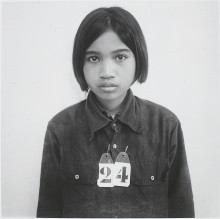Researcher: Asian Institute Affiliate Carla Rose Shapiro
Scant scholarly attention has been paid to the genocide in Cambodia relative to the Holocaust, and genocides perpetrated subsequently. Fewer still are the number of studies which consider the representation of the Cambodian genocide through the prism of memorial sites on the grounds of the former Killing Fields.i My research will add to a body of scholarship on genocide and representation with a particular focus on the Cambodian genocide.
Exhibiting The Cambodian Genocide will examine the exhibitions and didactic materials at the Tuol Sleng Museum of Genocide and the Choeung Ek Genocidal Center. My research will commence with a summary of the historical and political circumstances of their creation in 1980, with special emphasis on the role of Vietnamese authorities in harnessing these sites as loci of the history and memory of Cambodia under the Khmer Rouge regime. Mai Lam, a Vietnamese colonel and museologist, was appointed to oversee the museumification of these sites. Significantly, before curating the Tuol Sleng Museum, Lam travelled to Poland to study the Auschwitz-Birkenau State Museum. I will examine the specific connections between the content and form of the Tuol Sleng Museum and the Auschwitz Museum. I will endeavour to compare the representation strategies employed at Tuol Sleng with its Holocaust museum predecessor. Does the particular representational approach employed to convey the destruction of European Jewry during the Holocaust offer an efficacious template to represent the victims of the Cambodian genocide? I will also query how modern-day political realities conflict with these original exhibition narratives.
Exhibiting The Cambodian Genocide will outline the highly complex interplay between the exhibition constituents, the imperatives of historical accuracy, the political messages conveyed, the sanctity required by the exhibition’s commemorative functions, and the demands on these sites as a centres of education and tourism. How are these varied interests addressed by the site itself? Are exhibition constituents configured in a manner that reflects the cultural and ethnic composition of the two million victims of the genocide? This includes the national minorities and religious groups who were persecuted and killed – non-Khmer Vietnamese and Chinese, and Muslim Cham. Do the museum and memorial site pay heed to traditional and contemporary Khmer art practices and architectural forms, as well as Buddhist aesthetics and mourning practices?
Exhibiting The Cambodian Genocide will offer a museological reading of the Tuol Sleng site with a focus on the display of thousands of anonymous photographs of its victims and the preserved artifacts of the prison. Before being taken to Choeung Ek Killing Field, meticulous care was taken to document and photograph each of the 20 000 people who entered Tuol Sleng. I will examine the ways in which the portraits of the victims of Tuol Sleng, and the other exhibition constituents, are used within the larger narrative structure of the exhibition and how they create and reinforce particular types of memory. Recently, new installations prepared by the Documentation Center of Cambodia were added to the extant Tuol Sleng Museum exhibition. The study will explore how contemporary interventions address more culturally appropriate strategies of visual and textual representation, taking into consideration new dialogues emerging as a result of the trials taking place at the Extraordinary Chambers in the
Courts of Cambodia.
